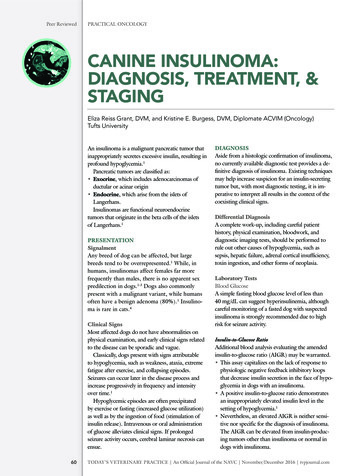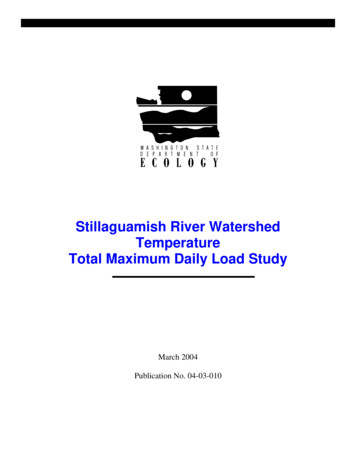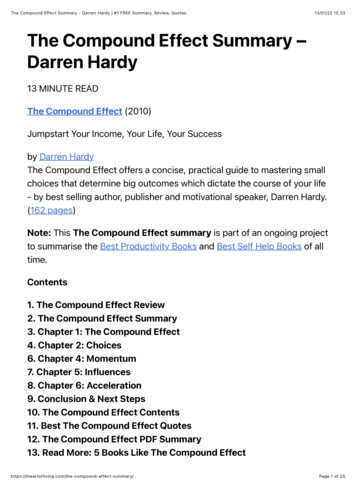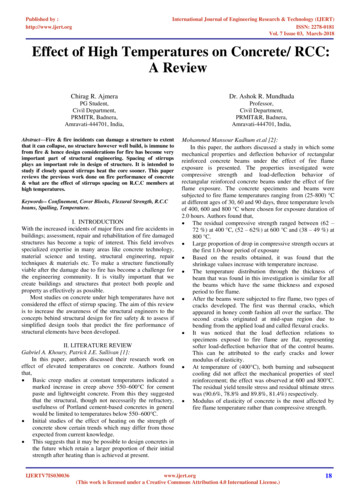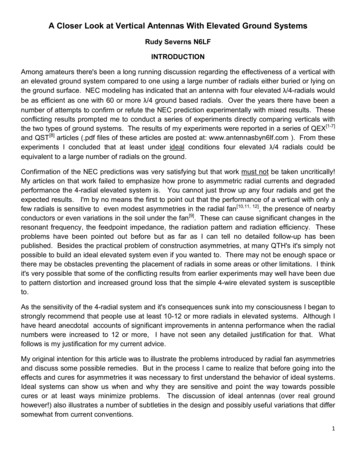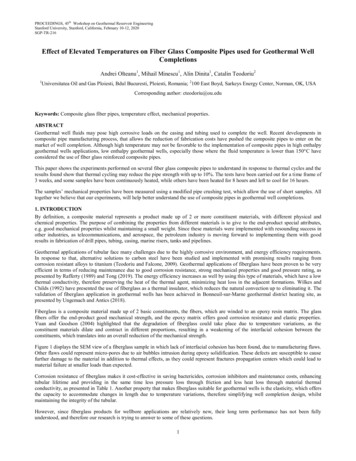
Transcription
PROCEEDINGS, 45th Workshop on Geothermal Reservoir EngineeringStanford University, Stanford, California, February 10-12, 2020SGP-TR-216Effect of Elevated Temperatures on Fiber Glass Composite Pipes used for Geothermal WellCompletionsAndrei Olteanu1, Mihail Minescu1, Alin Dinita1, Catalin Teodoriu21Universitatea Oil and Gas Ploiesti, Bdul Bucuresti, Ploiesti, Romania; 2100 East Boyd, Sarkeys Energy Center, Norman, OK, USACorresponding author: cteodoriu@ou.eduKeywords: Composite glass fiber pipes, temperature effect, mechanical properties.ABSTRACTGeothermal well fluids may pose high corrosive loads on the casing and tubing used to complete the well. Recent developments incomposite pipe manufacturing process, that allows the reduction of fabrication costs have pushed the composite pipes to enter on themarket of well completion. Although high temperature may not be favorable to the implementation of composite pipes in high enthalpygeothermal wells applications, low enthalpy geothermal wells, especially those where the fluid temperature is lower than 150 C haveconsidered the use of fiber glass reinforced composite pipes.This paper shows the experiments performed on several fiber glass composite pipes to understand its response to thermal cycles and theresults found show that thermal cycling may reduce the pipe strength with up to 10%. The tests have been carried out for a time frame of3 weeks, and some samples have been continuously heated, while others have been heated for 8 hours and left to cool for 16 hours.The samples’ mechanical properties have been measured using a modified pipe crushing test, which allow the use of short samples. Alltogether we believe that our experiments, will help better understand the use of composite pipes in geothermal well completions.1. INTRODUCTIONBy definition, a composite material represents a product made up of 2 or more constituent materials, with different physical andchemical properties. The purpose of combining the properties from different materials is to give to the end-product special attributes,e.g. good mechanical properties whilst maintaining a small weight. Since these materials were implemented with resounding success inother industries, as telecommunications, and aerospace, the petroleum industry is moving forward to implementing them with goodresults in fabrication of drill pipes, tubing, casing, marine risers, tanks and pipelines.Geothermal applications of tubular face many challenges due to the highly corrosive environment, and energy efficiency requirements.In response to that, alternative solutions to carbon steel have been studied and implemented with promising results ranging fromcorrosion resistant alloys to titanium (Teodoriu and Falcone, 2009). Geothermal applications of fiberglass have been proven to be veryefficient in terms of reducing maintenance due to good corrosion resistance, strong mechanical properties and good pressure rating, aspresented by Rafferty (1989) and Tong (2019). The energy efficiency increases as well by using this type of materials, which have a lowthermal conductivity, therefore preserving the heat of the thermal agent, minimizing heat loss in the adjacent formations. Wilkes andChilds (1992) have presented the use of fiberglass as a thermal insulator, which reduces the natural convection up to eliminating it. Thevalidation of fiberglass application in geothermal wells has been achieved in Bonneuil-sur-Marne geothermal district heating site, aspresented by Ungemach and Antics (2018).Fiberglass is a composite material made up of 2 basic constituents, the fibers, which are winded to an epoxy resin matrix. The glassfibers offer the end-product good mechanical strength, and the epoxy matrix offers good corrosion resistance and elastic properties.Yuan and Goodson (2004) highlighted that the degradation of fiberglass could take place due to temperature variations, as theconstituent materials dilate and contract in different proportions, resulting in a weakening of the interfacial cohesion between theconstituents, which translates into an overall reduction of the mechanical strength.Figure 1 displays the SEM view of a fiberglass sample in which lack of interfacial cohesion has been found, due to manufacturing flaws.Other flaws could represent micro-pores due to air bubbles intrusion during epoxy solidification. These defects are susceptible to causefurther damage to the material in addition to thermal effects, as they could represent fractures propagation centers which could lead tomaterial failure at smaller loads than expected.Corrosion resistance of fiberglass makes it cost-effective in saving bactericides, corrosion inhibitors and maintenance costs, enhancingtubular lifetime and providing in the same time less pressure loss through friction and less heat loss through material thermalconductivity, as presented in Table 1. Another property that makes fiberglass suitable for geothermal wells is the elasticity, which offersthe capacity to accommodate changes in length due to temperature variations, therefore simplifying well completion design, whilstmaintaining the integrity of the tubular.However, since fiberglass products for wellbore applications are relatively new, their long term performance has not been fullyunderstood, and therefore our research is trying to answer to some of these questions.1
Olteanu et al.Figure 1. Manufacturing imperfections of fiber glass samples used in this paperTable 1. Thermal conductivity for materials used in geothermal applications2oMaterial typeThermal conductivity Btu in / (h ft F)Fiberglass (Epoxy)2.8Ductile iron240Carbon steel 1 %C297.6Steel - Chrome, 5% Cr277.2Steel - Chrome Nickel, 15% Cr, 10% Ni132Steel - Chrome Nickel, 20% Cr, 15% Ni104.762. EXPERIMENTS AND RESULTSIn order to test the influence that temperature has over the fiberglass composite tubular, as to proposing them as pertinent solutions forgeothermal wells implementation, a series of experiments have been conducted. The pipe has been sampled in circular shape andsubjected to temperature loading by submersion in a hot bath with distilled water, preset to 60 C to simulate the heating and coolingconditions. The experiment took place over a 3 weeks period, 3 of the samples being subjected to thermal cycles – 8 hours of thermalloading with 16 hours of cooling down, whereas one sample has been continuously exposed to the same temperature of 60 C. The 60 Ctemperature have been selected, as it is considered to be the temperature at which heat distortions may occur for common resins.Although geothermal wells may face higher temperatures, a 60 C condition may exists when the surface casing is made of fiber glassmaterials. Some other geothermal wells have used fiber glass tubing up to 90 C conditions, in low temperature geothermal wells.In order to quantify the effect of temperature over the material strength, a pipe-crushing setup has been used, while the unexposedsample was tested both using the crushing device as well as the standard tensile testing procedure for reference. The device consists of ahydraulic press which records the force at which the plastic deformation occurs, as shown in Figure 2. This force is then corrected byconsidering the thickness of each sample. A force versus displacement measurement is shown in Figure 3. The almost linear behaviorcan be observed until the maximum force is reached followed by an abrupt force decrease. The maximum force is then used tocharacterize the sample resistance. All linear portions of the 5 tests are shown in Figure 4 whereas an interesting behavior is observed:after first thermal cycle, the tested sample after first cycle seems to be stronger as the original not exposed sample. Although thisvariation is small, it has been considered not being influenced by the measurements error. The results presented in Figure 5 show adecrease in the material strength with up to 10% for the sample which has been continuously exposed to temperature. This decreasecould be explained by a more intense thermal degradation of the epoxy matrix rather than the weakening the interface between the 2constituents, as previously mentioned. The mechanisms through which temperature affects the epoxy are known as the hygrothermaldegradation – the infiltration of moisture in the epoxy with the effect of weakening the structure, as presented by Karbhari (2019) andthe hydrolytic degradation, through which water is absorbed and bonded to the polymer structure, causing other components of thematrix to leach, resulting in a mass loss, as presented by Krauklis et al. (2003). These drawbacks of the fiberglass do not make it suitable2
Olteanu et al.for high enthalpy geothermal applications, as the effects mentioned are accelerated by temperature, but makes it a reliable technicalsolution for use in low enthalpy geothermal wells, both for injectors and producers.Figure 2. Pipe-crushing testing setupFigure 3. Example Force - Displacement Chart of sample 33
Olteanu et al.Figure 4. Linear portion of the Force - Displacement Chart for all samplesFigure 5. Thermal loading influence on fiberglass composite pipes showing a slight decrease of the mechanical properties withtime4
Olteanu et al.3. DISCUSSIONSA very interesting characteristic obtained through experiments was the slight increased of sample strength after the first cyclic test.Diniţă et al. (2019) have shown that depending of the medium at which the samples are stored at elevated temperature, the ultimatetensile strength may increase after 24 hours by 3 to 5%. Our data shows an increase of about 2 % in hot water.The importance of the experimental work presented above lies in the possibility to further predict the composite pipe strength over time.Figure 4 shows a decrease of the force vs. displacement slope over time at temperature exposure which indicates a change in E-modulusof the material.Although our experiments are not necessary representative for all market available composite pipe, the samples we have tested show aclear thermal degradation of mechanical properties, which actually was also shown by other researchers (Shokry, 2014, Diniţă et al.,2019). Although we agree that our data is limited at this stage, we have performed an extrapolation of our results as shown in Figure 6.The data shows that the composite pipe exposed continuously at 60 C may lose its strength after approximately 36 weeks of continuousexposure, while a similar pipe exposed to thermal cycles will fail after 47 weeks. Since our tests was a crushing test, the above resultswill apply only to the composite pipe crushing resistance.Figure 6. Thermal loading influence on fiberglass composite pipes showing the estimate time to failure for crushing resistance4. CONCLUSIONSDesigning the completion of low enthalpy geothermal wells by the help of fiberglass composite tubular is proving to be a very simplisticand optimistic approach in order to minimize well intervention, save costs related to corrosion prevention and complex devices toaccommodate tubular length change.In this paper authors presented an experimental study in which fiberglass composite degradation with temperature has been evaluatedand quantified, by taking into consideration various scenarios which could be found throughout the lifetime of a geothermal well,whether an injector or a producer.The scenarios follow thermal cycling and continuous exposure to temperature loading, which lead to the result that epoxy matrixdegradation due to temperature decreases the strength of the material with about 10% for a 3 weeks exposure.Extrapolating our current data, shows that the tested composite samples will only survive for about 36 weeks at continuous exposure to60 C temperature or 47 weeks at daily cycles. However, due to limited amount of current data, the presented results should be carefullyused, especially for other type or composite fiberglass systems.5
Olteanu et al.At this point, long term investigations on composite fiber glass pipe are necessary to fully understand the degradation mechanism atelevated temperatures.REFERENCESDiniţă, A., Minescu, M., Dumitrescu, A., Teodoriu, C., and Săraru, C. Ş., Assessment of Variations in the Physico-MechanicalProperties of Fiberglass Tubing Working in Different Environments, Proceedings of the ASME 2019 38th International Conferenceon Ocean, Offshore and Arctic Engineering. Volume 8: Polar and Arctic Sciences and Technology; Petroleum Technology.Glasgow, Scotland, UK. June 9–14, 2019. V008T11A047. ASME. https://doi.org/10.1115/OMAE2019-96283Karbhari, V.M., Hygrothermal Effects on Transition Behavior of Carbon-FRP Composites - Proceedings of The Thirteenth (2003)International Offshore and Polar Engineering Conference Honolulu, Hawaii, USA, May 25–30, 2003, I-03-374 ISOPE ConferencePaper - 2003Krauklis, A.E., Gagani, A.I., Echtermeyer, A.T., Long‐ Term Hydrolytic Degradation of the Sizing ‐ Rich Composite Interphase Coatings 2019, 9(4), 263; https://doi.org/10.3390/coatings9040263Rafferty, K.D., Geothermal Direct-Use Engineering and Design Guidebook Volume 12693, Issue 2 of US Department of Energy. DOEID, 1989- Chapter 10 - Piping Geo-Heat Center Klamath Falls, OregonShokry, K.M., Effect of Temperature on Mechanical Properties of Glass Reinforced Plastic GRP, World Applied Sciences Journal 31(7): 1341-1344, 2014ISSN 1818-4952 IDOSI Publications, 2014 DOI: 10.5829/idosi.wasj.2014.31.07.14463Tong, C., Introduction to materials for advanced energy systems - Springer, Chicago, Il, USA ISBN 978-3-319-98001-0, 2019Teodoriu, C.; Falcone, G.Comparing completion design in hydrocarbon and geothermal wells: the need to evaluate the integrity ofcasing connections subject to thermal stresses, Geothermics journal, doi:10.1016/ j.geothermics.2008.11.006, 9 January 2009.Ungemach, P., Antics M., Anti-Corrosion Well Concept Validated in the Paris Basin, Published July 31, 2018 GDCE18052 pressrelease-v2, alidated-paris-basin/Wilkes, K.E., Childs, P.W., Thermal Performance of Fiberglass and Cellulose Attic Insulations, Conference on Thermal Performance ofthe Exterior Envelopes of Buildings V Clearwater Beach, Florida December 7-10, 1992, CONF-921203--3 DE92 040714Yuan, Y., Goodson, J. Advanced Composite Downhole Applications and HPHT Environmental Challenges 04616 NACE ConferencePaper - 20046
The tests have been carried out for a time frame of 3 weeks, and some samples have been continuously heated, while others have been heated for 8 hours and left to cool for 16 hours. The samples' mechanical properties have been measured using a modified pipe crushing test, which allow the use of short samples.


